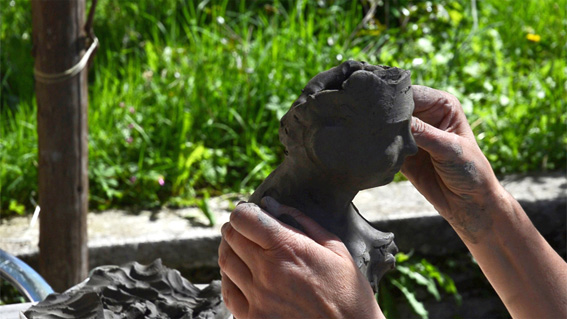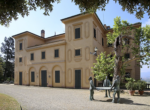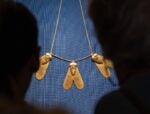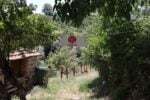Chiara Camoni / Nona Inescu

La storia viene sempre dopo, quarta mostra personale dell’artista Chiara Camoni (1974, Piacenza), nello spazio di Via Amati 13, Pistoia e Conversazione con una pietra, una mostra personale di Nona Inescu (1991, Bucharest, Romania) negli spazi del project space della galleria.
Comunicato stampa
Chiara Camoni
La storia viene sempre dopo
INAUGURAZIONE: 19 NOVEMBRE, 2016 -ore 18
FINO AL : 13.01.17
MAR - SAB 11 - 14 / 15 - 19 o su appuntamento
Comunicato Stampa
SpazioA ha il piacere di presentare, sabato 19 novembre 2016, ore 18, La storia viene sempre dopo, quarta mostra personale dell’artista Chiara Camoni (1974, Piacenza), nello spazio di Via Amati 13, Pistoia.
Uscite di casa di buon mattino.
Recatevi con un contenitore e una paletta
nel luogo prescelto.
Scavate un po’ di terra e portatela via.
Arrivati a casa, purificatela da sassolini,
vegetali o altro.
Aggiungete acqua se necessario.
Impastatela con le mani fino a raggiungere
una buona consistenza.
Deve essere morbida ma non appiccicosa.
Ora avete un panetto di terra, potete procedere.
Modellate il corpo.
Aggiungete 4 zampe.
Il collo e la testa.
Le orecchie.
Con la punta di una matita fate sul muso gli occhi.
Mettete la coda.
Può stare dritta o abbassata.
Oppure scodinzolare.
(Chiara Camoni, Esercizio di self-learning per Maria Rosa, giugno 2016)
Chiara Camoni spia il rapporto che l’opera intrattiene con la realtà. I lavori di questa mostra raccontano anche ciò che avviene prima di loro e ciò che ne segue, ovvero il processo creativo e la storia che poi ne scaturisce.
Il prima e il dopo: due zone che forse non competono l’opera - che si basta da sé - ma che sembrano continuamente affacciarsi nel lavoro di Chiara Camoni, con ironia e apprensione.
Nell’installazione video Una storia, seguiamo le fasi di realizzazione di una scultura che non compare in mostra. Ai passaggi tecnici e artigianali, si sovrappongono i suoni e i pensieri della vita di tutti i giorni, che insieme creano un basso continuo. Si va verso l’opera, ma anche verso una riflessione esistenziale.
Le sculture-fischietto dichiarano un’ambiguità esplicita: stanno, come devono stare le sculture sul proprio basamento, ma allo stesso tempo chiedono di essere prese e suonate. La loro presenza nello spazio si compie nel momento in cui una persona si relaziona ad esse, assume una posizione in conseguenza alla loro forma, immette aria, ottiene una nota.
Dell’agglomerato Senza Titolo, la grande madre astratta, vediamo solo una delle possibilli sue forme. Creatura morbida e tagliente allo stesso tempo, può cambiare continuamente; seguendo il disegno delle sue spirali seguiamo la narrazione di una delle tante storie.
E la narrazione si sa, avviene sempre dopo, quando la notte se n’è andata.
Chiara Camoni (1974, Piacenza) si diploma all’Accademia di Belle Arti di Brera. Tra le mostre recenti segnaliamo: Anachronikos, CAC, Vilnius; Gli immediati dintorni, Nomas Foundation, Roma; Dall’oggi al domani, MACRO, Roma, Autoritratti, MAMbo, Bologna; Fig. 2: Natura Morta, GNAM, Roma; Un'idea di bellezza, CCC Strozzina, Firenze; Punti di vista. Identità, conflitti, mutamenti, Galleria Nazionale, Cosenza; Archéologies Contemporaines, Musée de Wurtemberg, Montbéliard; Certe Cose, Galleria SpazioA, Pistoia; Nell’ordine del discorso, Museo Marino Marini, Firenze; Vedere un Oggetto, Vedere la Luce, Fondazione Sandretto Re Rebaudengo, Guarene, Cuneo; Vive e lavora a Seravezza, tra le colline della Versilia.
Chiara Camoni
The story always comes later
OPENING: NOVEMBER 19, 2016 - 6PM
UNTIL : 13.01.17
TUE - SAT 11am - 2pm / 3pm - 7pm or by appointment
Press Release
SpazioA is proud to present, Saturday November 19, 2016, 6pm, The story always comes later, the fourth solo show of the artist Chiara Camoni (1974, Piacenza, Italy), in Via Amati 13, Pistoia.
Step out the door early in the morning.
Head to the chosen place with container
and trowel in hand.
Dig a little into the soil; take away some.
At home, sift out bits of stone, plant,
everything but soil.
Add water if necessary.
Knead it with your hands until you reach
the right consistency.
It must be soft, not sticky.
Now that you have a clump of soil, you can continue.
Model the body.
Add 4 legs.
The neck and the head.
The ears.
Use the point of a pencil to punch eyes into the snout.
Add a tail.
It can stand straight up or hang down.
Even wag.
(Chiara Camoni, Self learning exercise, for Maria Rosa, June 2016)
Chiara Camoni spies on the relationship that a work of art maintains with reality. The works in this show also relate what happens before them and what happens after, the creative process, and the story that ensues.
Before and after: two areas not usulally considered a part of the work – complete as it is in itself – but which seem to emerge continually with irony and apprehension in the art of Chiara Camoni.
In the video installation A story we are shown the steps in the creation of a sculpture not featured in the show. The technical steps and craftsmanship are overlapped by the sounds and thoughts of daily life providing a continuous bass line in the background. Things head in the direction of the work of art, but also towards a reflection on existence.
The sculptures-whistles clearly express ambiguity, assuming their positions on their stands as all sculptures do while requesting to be taken in hand and played at the same time. Their presence in space is enacted in the moment some person enters into relationship with them, takes the position required by their form, blows air inside, and produces a sound.
In the agglomeration Senza Titolo the great abstract mother figure, we see only one of its possible forms. A creature that is both soft and piercing at the same time, it can change continually; studying the pattern of its spirals allows us to follow the narration of one of its many stories.
And the story, as we know, always comes later, after the night has come to an end.
Chiara Camoni (1974, Piacenza,Italy) graduated in Sculpture from Brera Academy of Fine Arts in Milan. Selected exhibitions: Anachronikos, CAC, Vilnius; Gli immediati dintorni, Nomas Foundation, Roma; Dall’oggi al domani, MACRO, Roma, Autoritratti, MAMbo, Bologna; Fig. 2: Natura Morta, GNAM, Roma; Un'idea di bellezza, CCC Strozzina, Firenze; Punti di vista. Identità, conflitti, mutamenti, Galleria Nazionale, Cosenza; Archéologies Contemporaines, Musée de Wurtemberg, Montbéliard; Certe Cose, Galleria SpazioA, Pistoia; Nell’ordine del discorso, Museo Marino Marini, Firenze; Vedere un Oggetto, Vedere la Luce, Fondazione Sandretto Re Rebaudengo, Guarene, Cuneo; Somiglianze non sensibili, Galerie Opdahl, Stavanger, Norvegia. She lives and works in Seravezza, in the Versilia Hills.
project space
Nona Inescu
Conversazione con una pietra
INAUGURAZIONE: 19 NOVEMBRE, 2016 -ore 18
FINO AL : 13.01.17
MAR - SAB 11 - 14 / 15 - 19 o su appuntamento
Comunicato stampa
SpazioA ha il piacere di presentare, sabato 19 novembre 2016, ore 18, Conversazione con una pietra, una mostra personale di Nona Inescu (1991, Bucharest, Romania) negli spazi del project space della galleria.
Il tatto definisce il confine tra il nostro sé e il mondo. Per questo si dice essere in “con-tatto”, cioè “con il tatto”. Oltre a stabilire un contatto con gli oggetti, abbiamo la possibilità di estendere i nostri corpi attraverso di loro, di farli diventare parte di noi. Basti pensare allo smartphone. Percepiamo, sperimentiamo il mondo attraverso questi oggetti, che dal punto di vista tattile diventano trasparenti. Quando interagiscono con noi, gli oggetti esercitano un “linguaggio del corpo”, si animano di pelle, ossa e muscoli. E nel contatto, non facciamo troppa differenza se l’oggetto con cui siamo in contatto è vivo o no: ci tocca, e in virtù di questo ha un significato affettivo.
Di solito il simbolo del tatto è la mano, anche se il tatto è un’esperienza che coinvolge tutto il corpo. Le mani rappresentano il tatto attivo, mentre il resto del nostro corpo viene toccato in modo più passivo. In ogni interazione fisica, entrambi i fenomeni si verificano in simultanea: tocchiamo e, così facendo, veniamo toccati. Il tatto ci rende reali. È anche rappresentato come il senso che non può essere ingannato o fuorviato. Le sensazioni tattili sono le prime a svilupparsi.
Conversazione con una pietra è una poesia scritta da Wisława Szymborska nel 1962, in cui l’autrice gioca con l’idea del sé che si confronta con il mondo esterno, tramite un dialogo immaginario tra la voce della poesia e una pietra. La persona che sta parlando bussa alla porta della pietra, chiede di entrare e la pietra rifiuta. In sostanza, chi parla rappresenta il desiderio umano di conoscere ogni dettaglio del mondo che ci circonda, e la pietra l’impossibilità della conoscenza. Perché la pietra, come scopriamo, non ha porte. Attraverso i suoi lavori, Nona Inescu cerca di continuare il dialogo con la pietra aprendo nuove possibilità di interazione attraverso il senso del tatto. Usando fotografie, oggetti, video e installazioni, dirige la sua attenzione sui fenomeni culturali che ruotano attorno al senso del tatto. Applicando un linguaggio poetico e spesso metaforico, Nona Inescu cerca di affrontare un’ampia gamma di soggetti in modo stratificato, ama coinvolgere lo spettatore in modo a volte fisico e nei suoi lavori mette in discussione l’idea della “forma che segue la funzione”.
Nona Inescu (1991, Bucharest, Romania), dopo aver studiato al Chelsea College of Art & Design di Londra (2009-2010) e alla Royal Academy of Fine Arts in Antwerp (2010-2011), ha completato i suoi studi nell’estate del 2016 alla National University of Arts in Bucharest (Dipartimento Fotografia e Video). Tra le ultime mostre personali: Her latent image, Kube Musette, Bucharest (2016); Hands don’t make magic, Sabot, Cluj-Napoca (2015). Il suo lavoro è stato incluso anche in mostre collettive, tra cui: Gestures of Tomorrow, Kunstverein Nürnberg - Albrecht Dürer Gesellschaft (2016); Künstlich, natürlich!, Sabot, Cluj-Napoca (2016); Events without a cause (II), part of Biennial of Contemporary Photography and Dynamic Image “Camera Plus”, Iasi (2016); Objects of Desire, Sabot, (2015); Megatron, Romanian Cultural Institute, Vienna (2015).
project space
Nona Inescu
Conversation with a stone
OPENING: NOVEMBER 19, 2016 -6pm
UNTIL : 13.01.17
TUE - SAT 11am - 2pm / 3pm - 7pm or by appointment
Press Release
SpazioA is proud to present, Saturday November 19, 2016, 6pm, Conversation with a stone, a solo exhibition by Nona Inescu (1991, Bucharest, Romania) at the gallery project space.
Touch defines the border between our self and the world. Being in “con-tact” means “with touch”. Next to being in touch with objects, we are able to extend our bodies through objects, to make them become part of us. Think of your smartphone. We feel, experience the world through these objects and they become tactually transparent. When interacting with us, objects exert a “body language”, they become animated with skin, bones and muscles. And in touch, we do not really make a difference whether the object we are in touch with is actually alive or not: it is touching us and thereby has affective meaning.
The hand is often the icon for touch, although touch is a full-body experience. The hands represent the active touch, while the rest of our body is more passively touched. In every physical interaction, both phenomena occur simultaneously: we touch and by that, we are being touched. Touch makes real. It is often depicted as the sense that cannot be deceived or fooled. Tactile sensations are the very first to develop.
Conversation with a stone is a poem written by Wisława Szymborska in 1962, where the author plays with the idea of the self-confronting with the external world, through an imaginary dialogue between the speaker of the poem and a stone. The speaker knocks on the stone’s door, asks the stone to step inside of it and the stone refuses. Essentially, the speaker represents the human desire to know each detail of the world around us, and the stone the impossibility of knowing. For the stone, we find, has no door. Through her works, Nona Inescu tries to continue the conversation with the stone by opening new possibilities of interaction through the tactile sense. Using photographs, objects, videos and installations Nona Inescu directs her attention to the cultural phenomena surrounding the sense of touch. By applying a poetic and often metaphorical language, Nona Inescu tries to approach a wide range of subjects in a multi-layered way, likes to involve the viewer in a way that is sometimes physical and challenges the idea of “form following function” in a work.
Nona Inescu (1991, Bucharest, Romania) after studying at the Chelsea College of Art & Design in London (2009-2010) and at the Royal Academy of Fine Arts in Antwerp (2010-2011), she has completed her studies in the summer of 2016 at the National University of Arts in Bucharest (Photography and Video Department). Recent solo exhibitions include: Her latent image, Kube Musette, Bucharest (2016); Hands don’t make magic, Sabot, Cluj-Napoca (2015). Her work has also been included in group exhibitions including: Gestures of Tomorrow, Kunstverein Nürnberg - Albrecht Dürer Gesellschaft (2016); Künstlich, natürlich!, Sabot, Cluj-Napoca (2016); Events without a cause (II), part of Biennial of Contemporary Photography and Dynamic Image “Camera Plus”, Iasi (2016); Objects of Desire, Sabot, (2015); Megatron, Romanian Cultural Institute, Vienna (2015).



